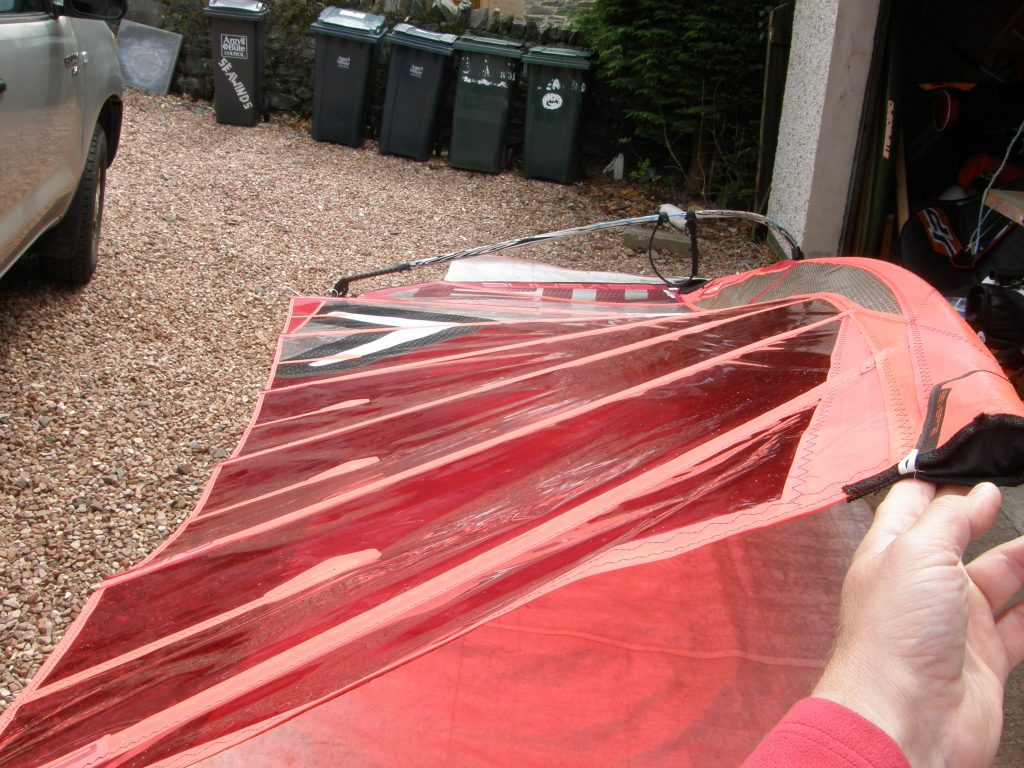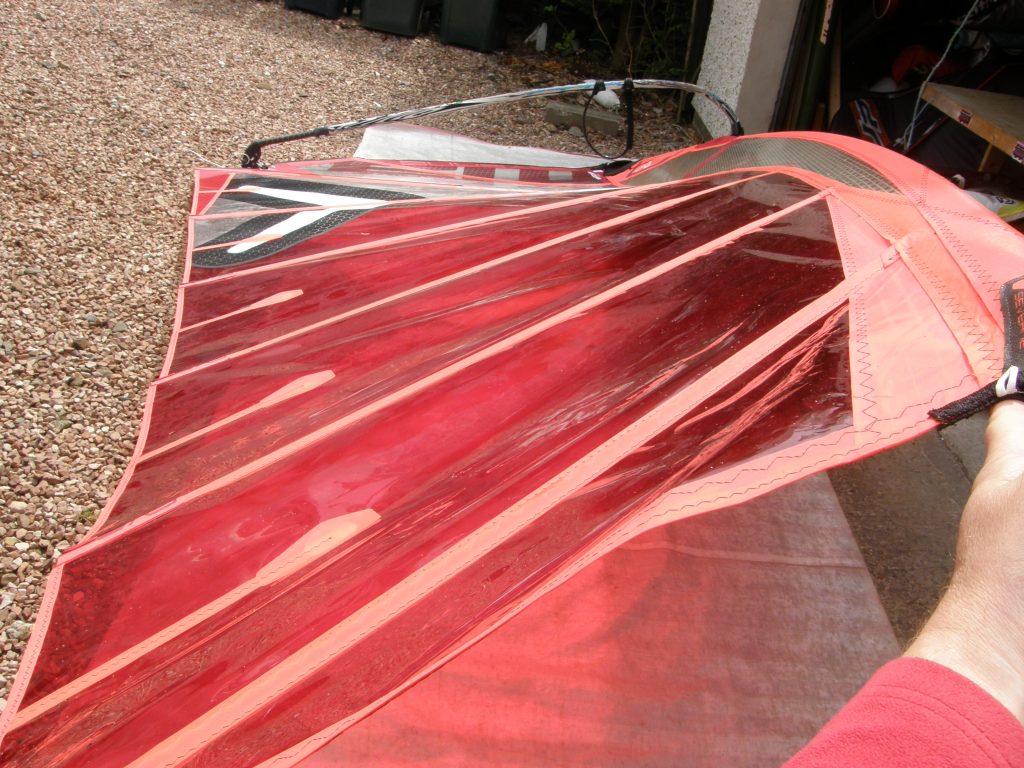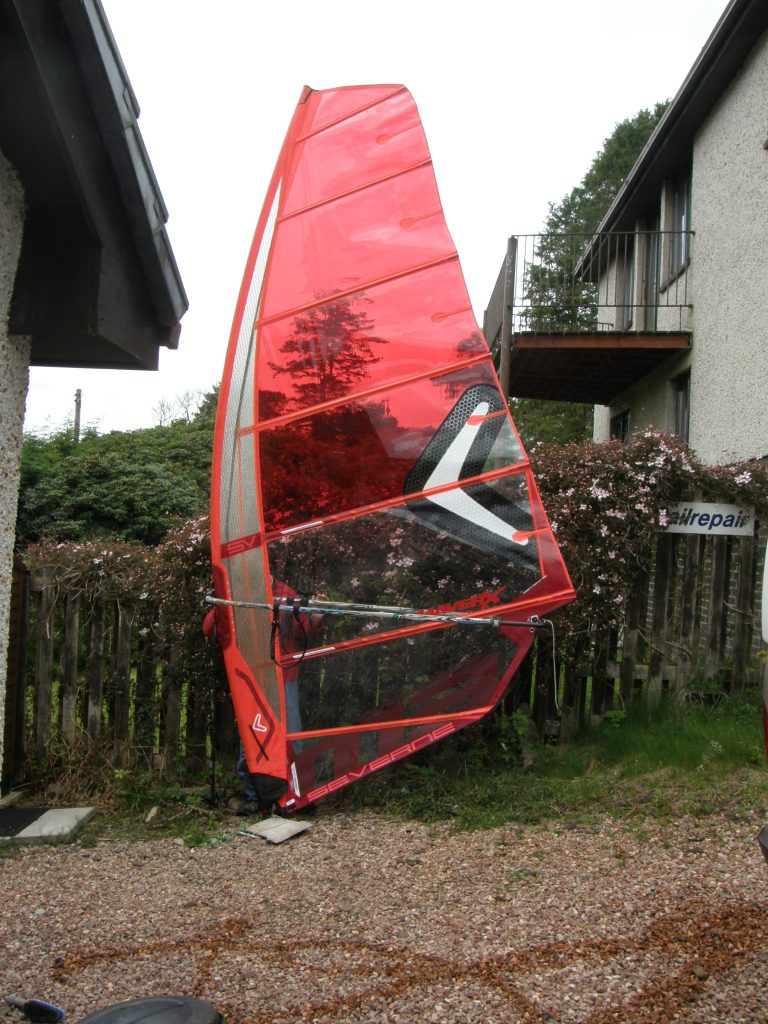Severne Overdrive M3 for foiling
First impressions – I have used the over drives on and off for many years on slalom boards and always found them to be a fast and pleasant to handle sail. When I first started foiling I was using overdrives but in my quest to conquer the flying gybe I changed to the Severne Turbo range of sails. Now that flying round gybes is no longer a consideration I thought it time to revisit my old friend the overdrive.
The overdrive is a 7 batten sail with 3 cams and a moderately wide mast sleeve. The mast sleeve is not as wide as that on full on slalom style sails but it is considerably wider than that found on most brands 2 cam sails. As you would expect from Severne the sails are reasonably light. The sails have all the refinements of a race sail such as adjustable outhaul compatible clew fittings, neoprene boom opening cover and quad tack pulleys on the larger sails which make downhauuling a breeze.
A notable point about the overdrives is that they can be used with either sdm or rdm masts by simply swapping the cams over. When I first did it I expected a lot of messing around with cam spacers but no, a straight swap of the cams and they worked great. I tend to use the sails from 7.0 downwards with rdm masts and the bigger sails I stick with sdm masts for best performance.
On the water – When rigging the sails for foiling you can rig them with about 2cm less downhaul than you would if you were using them on a slalom board. They will still rotate well and they will have a tighter and more responsive to pumping leech. Talking of downhaul – on some of the sails the printed dimensions can be out a bit so even for a normal fin sailing set you might rig the sail with 2cm less than it says and for foiling it may be as much as 4cm less than the dimensions printed on the sail. The downhaul is quite critical to the wind range of the sail. Take the 7.8 for example rigged in foiling mode the sail will get you flying early and have the range of a good 7.5m sail. If you rig it to its slalom setting then it has the wind range of a good 7.0m sail, it will take more wind to get you going but you can then hang onto it into some seriously windy conditions.


Before you uphaul it is worth mentioning that water seldom gets into the large sleeve so it is rarely any problem to uphaul the sail. Getting flying is directly linked to what I said about the downhaul setting. Rigged for foiling the leech will have a useful spring to it letting you pump up onto the foil easily.
In flight the Overdrive pulls steadily and aids stable flight. How the sail reacts to gusts will depend on how much downhaul you have on. When set with minimum downhaul the sail will accelerate forward without issue or drama. As the wind increases the pressure builds and you have to either sink into your harness to keep the board down for top speeds or alternatively back off a touch for a relaxed ride. If you have the sail set near the printed dimensions it will shrug off most gusts as if they were not there. In severe overpowering gusts if you have a lot of downhaul on the sail so that it has a very soft leech the sail can get a bit noisy if you have to fly half sheeted out but in such circumstances you really should be on a much smaller sail.
The semi wide mast sleeve will see you cruising through holes in the wind which would see narrower sleeved sails coming off the foil. It is a combination of the wider sleeve plus a finer entry into the draft of the sail which increases the sail’s efficiency. The less blunt leading edge also increase the angle you can sail into the wind.
Gybing is straight forward and if the sail is rigged on a rdm mast the maneuverability is enhanced. For a 3 cam sail the Overdrive has few competitors for ease of rotation.
Comparisons – Compared to the Severne Turbo the overdrive has a bit more “slippy through the air” feeling. The Overdrive has a higher top end but maybe not as good a low end as the Turbo. I would certainly recommend a turbo as your first foiling sail but I would not do the same with the Overdrive. The Overdrive suits sailors who have been foiling for a while and looking for the next step towards faster foiling. Compared to full race and foil race sails the Overdrive is lighter and more maneuverable but ultimately not quite as efficient but you would have to be very good on the foil to notice. Compared to foil specific sails like the Pryde V8 flight the Overdives are easier in gusty conditions, you would easily be able to hold onto a Overdrive in winds that would see you changing down many foil sails.
Overall – I would certainly recommend the Overdrive to anyone just wanting to go quick on a foil. By “quick” I mean relative to the windspeed. The sails ability to cruise through holes in the wind is impressive and while some people may be put off by the size of the mast sleeve and the mention of camber inducers the overdrive feels light and easy.

M4
As you can see from above I have always been a fan of the Severne Overdrives both for foil and fin use. The M4 version is a bit different to its predecessors. In all past versions if you did not give them enough downhaul they would have a bit too blunt an entry into the sails profile and ultimately if you reality had no downhaul the cams would pop off the mast. But with the new M4 the cams start to get a bit reluctant to rotate if you don’t have sufficient downhaul. The end result is the sails rigging range is all a bit more top end orientated (looser leach) than previous versions. This isn’t a bad thing but something to keep in mind if you are pairing a M4 with a M3 or older version in your quiver.

Getting flying on a foil does take a tiny bit more wind as the leach doesn’t have so much spring to it but the M4 seems a bit fuller in the body so it does power you up onto the foil or plane with ease and it is only when you are trying to actively force it to fly or plane early that you notice the soft nature of the leach.
In flight the overdrive looks after itself with the majority of gusts going unnoticed. It lets you concentrate on squeezing as much speed as you can out of your foil. Ultimately as the wind increases and if you are hit by strong gusts it does produce quite a lot of mast foot pressure which can reduce your flight height but this can be viewed as a positive trait and avoids overfoiling when you get that surge of speed from the increased wind. This is really only noticeable when you should have changed down sail size long ago. The M4 will not point as high as the dedicated foil course racing sail. It has more of a leaning towards PWA style down wind slalom racing. Recreationally the M4 will take you both up and down wind as much as you like and it does it in a comfortable manner without feeling like you have more sail pressure than you would like.
Gybeing – the M4 retains the great rotation of its predecessors. The sail is a bit fuller so it does rotate with a noticeable “thud” but it is then wanting to accelerate and in doing so keeps you flying out of the gybe. These sails are noticeably lighter than the foil race sails like the HGO and you can appreciate that lightness in the gybes.
In Summary the M4 is a fast yet easy to use sail. It comes into its own once there is enough wind to continually fly where its on foil stability and easy handling can be inspiring.

